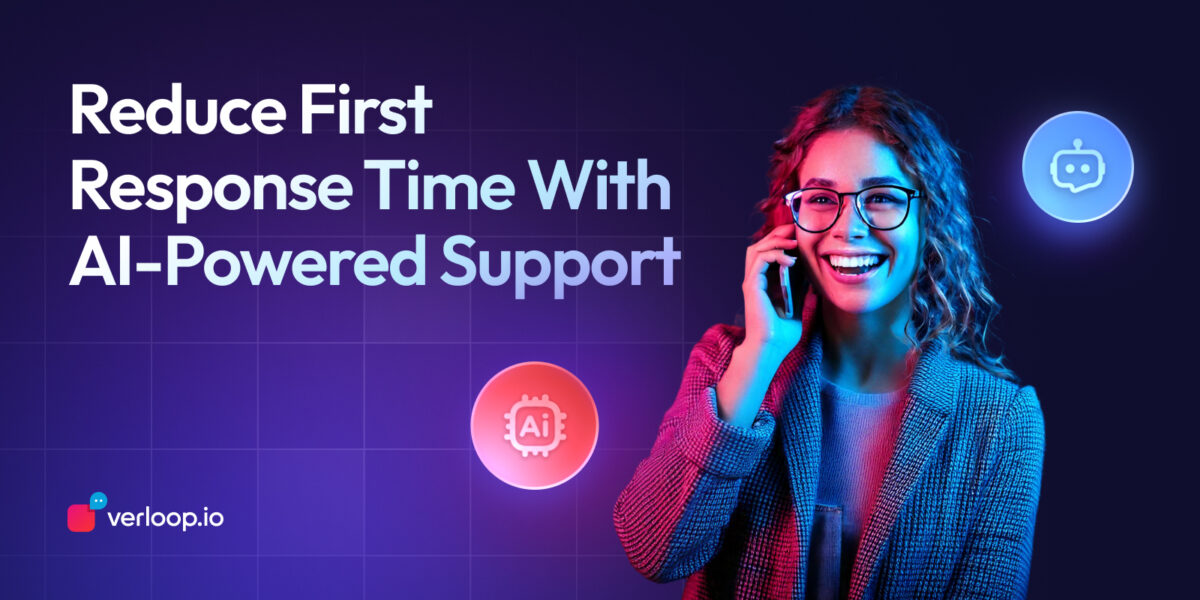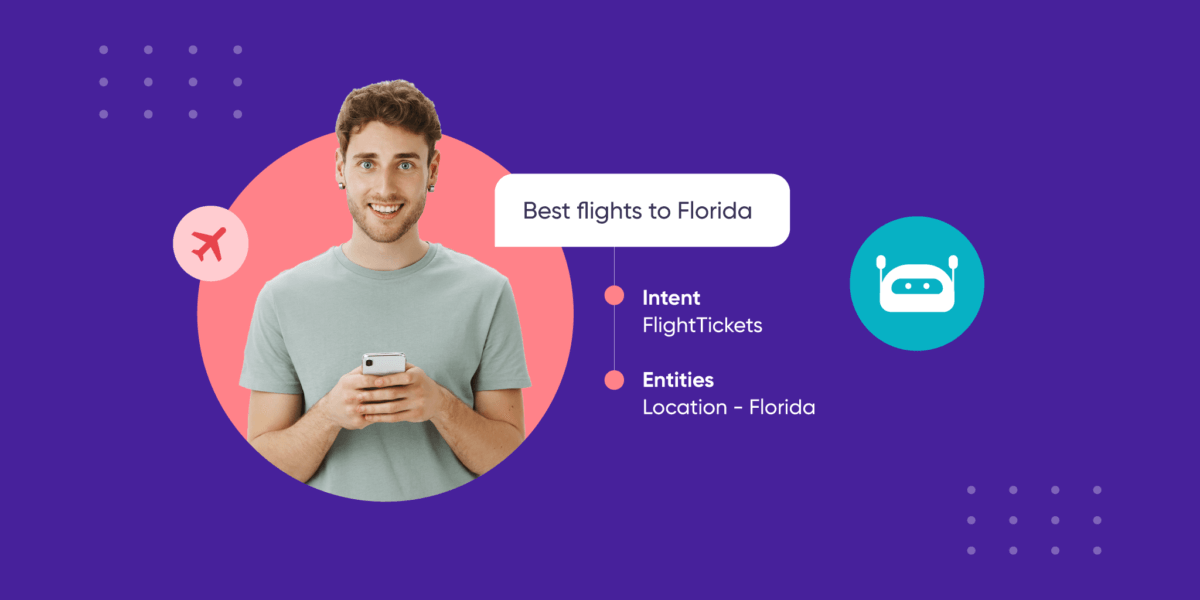
Intents and Entities – The Building Blocks of an AI Chatbot
- August 13th, 2025 / 8 Mins read
-
 Aarti Nair
Aarti Nair
Imagine you walk into a café and tell the barista, “I’d like a cappuccino with oat milk, please.” Instantly, the barista knows two things: what you want (a cappuccino) and a specific detail about your order (oat milk). Now, think of your AI chatbot as that barista. To respond accurately to your customer, it first needs to understand what the customer intends and the specific details within that request.
In the world of AI chatbots, these “what” and “details” are formally known as intents and entities. Intents capture the purpose behind a user’s message, like “ordering coffee” or “checking an account balance,” while entities capture key information within that intent, such as “oat milk” or “savings account.”
Getting these building blocks right is essential for chatbots to understand users, provide relevant responses, and deliver a seamless experience. In fact, a poorly designed chatbot that misinterprets intents or misses entities can leave customers frustrated—think of asking for a cappuccino and receiving a plain black coffee instead!
The AI technology that fuels the effectiveness of chatbots is Natural Language Processing (NLP). It helps machines understand human language and vice versa. But before delving deeper into this, let’s understand the equation and the variables behind the functionality of a chatbot.
- Utterance
An utterance is a query, or a sentence typed in by a user. These are often complete sentences or meaningful phrases.
- Intent
Intent refers to a user’s goal behind a command or a query. It denotes the intention behind a user’s “utterance.”
- Entity
An entity can act as a modifier. It is referred to as the data user shares to describe their “intent.” It provides more context for the machine to resolve the query.
Let’s try to understand these terms better with the help of an example:
“Show me the fastest way to Cubbon Park.”
Here, the utterance is the complete phrase. The intent here can be “get Directions,” and the entity will be “fastest” and “Cubbon Park” as they provide context to the user intent.
In a nutshell, intents and entities give directions to Chatbots and enable them to meet customers’ needs in the best way possible. But to better understand how exactly intents and entities make chatbots functional, let’s dive into certain concepts more deeply.
Table of Contents
- What is intent in a chatbot?
- What is an entity in a chatbot?
- Are there different types of entities in NLP?
- How are intents and entities different?
- What are some examples of chatbot intents & entities in different industries?
What is intent in a chatbot?
At its core, an intent is the purpose behind a user’s message—the “what” the user wants to achieve. When someone types or says something to a chatbot, the system’s first job is to understand their intention. Are they asking a question, making a request, or looking for support? That’s what intents help determine.
For example, imagine a customer messaging a retail chatbot:
“I want to track my order.”
Here, the intent is clear: track order. The chatbot recognises this intent and knows it should provide updates on shipping or order status.
Or consider a banking scenario:
“Can I transfer money to my savings account?”
The intent here is money transfer, which signals the chatbot to initiate the appropriate workflow.
Without correctly identifying intents, a chatbot might respond with irrelevant information, frustrating the user. This is why intents are fundamental—they form the foundation for meaningful, actionable interactions.
In short, intents guide the chatbot on what action to take based on the user’s request. Later, we’ll see how entities fill in the details to make responses precise and personalised.
Chatbot Intent Classification
This is a complex process where the machine takes the user’s utterances and classifies them into pre-defined buckets. The system takes the help of NLP models, which have evolved over the years to understand languages humans use and then categorise them into different buckets. The developer determines these buckets or functions carefully. Later, he processes an action or a result to be served to the user accordingly.
Chatbot Intent Dataset
Intent Classification is an essential task for any chatbot. One of the biggest challenges during this process is customising it for your specific business logic, which is solved using intent datasets. This dataset trains your system to identify users’ queries’ intent correctly. These datasets often define intents, how to identify those intents, entities that modify intents, and the action to be taken for this intent specific to your industry and use cases.
You can read more about user intents in artificial intelligence here.
What is an entity in a chatbot?
If intents answer the “what” behind a user’s message, entities answer the “details” or the “specifics” needed to complete the action. They act like the building blocks that give the chatbot context and precision.
For instance, consider the earlier retail example:
User: “I want to track my order #A12345.”
The intent is track order, but the entity is the order number #A12345. Without this entity, the chatbot wouldn’t know which order to track.
Similarly, in banking:
User: “Transfer $500 to my savings account tomorrow.”
Here, the intent is money transfer, and the entities are:
-
Amount: $500
-
Target account: Savings
-
Date: Tomorrow
By extracting these entities, the chatbot can execute the task accurately, schedule it correctly, and provide a personalised response.
Entities can take many forms—numbers, dates, locations, product names, or any piece of information that completes the user’s request. Together with intents, entities allow chatbots to move beyond generic replies and handle complex interactions efficiently.
Think of it like giving the chatbot both the instruction (intent) and the tools (entities) to get the job done.
Different types of entities in NLP
Entities are pre-dominantly divided into two categories within Natural Language Processing (NLP)
1. System-defined entities
System defined entities are readily available entities that are pre-built within the system. A few examples of such entities can be a user’s current date, current time, location, email addresses, phone numbers, URLs and more!
2. Custom entities
Custom entities are not well-established within the system. They are narrowed down to the specifics to match users’ needs and preferences. Examples of such entities are a user’s transaction history, a cab ride, a travel ticket, a shopping query, and more!
These different entities can take over following the intent and accurately delivering results.
How are intents and entities different?
| Aspect | Intent | Entity |
|---|---|---|
| Definition | The purpose or goal behind a user’s message. | The specific data or details that provide context to the intent. |
| Answers the question | “What does the user want to do?” | “Which item, value, or information is involved?” |
| Example (Retail) | Track order | Order number (#A12345) |
| Example (Banking) | Money transfer | Amount ($500), Target account (Savings), Date (Tomorrow) |
| Function | Guides the chatbot on the action to take. | Supplies the chatbot with the necessary details to execute the action. |
| Focus | Action-oriented | Data-oriented |
| Type | Broad and goal-driven | Specific and descriptive |
There is a fundamental difference between intents and entities. The intent is the action initiated by the user or a goal they have in mind, conversely, the entity is what refines, modifies and gives more context to the said action or intent. Intent can be arbitrary and refer to many things, but entities can be condensed to texts, data or fields.
Through Natural Language Processing, intents and entities in chatbots co-exist and make AI chatbots reliable and user-friendly.
For example, if the user query is “what is the temperature today in Amsterdam?” The user intent is to find out the weather conditions in Amsterdam, and the entity becomes “temperature” “today” and “Amsterdam.” after extracting the same from the user utterance.
Similarly, if the user intent is “what is the score for today’s football match?”, the entity is “score”, “today”, and “football match.” This information is extracted from user utterances!
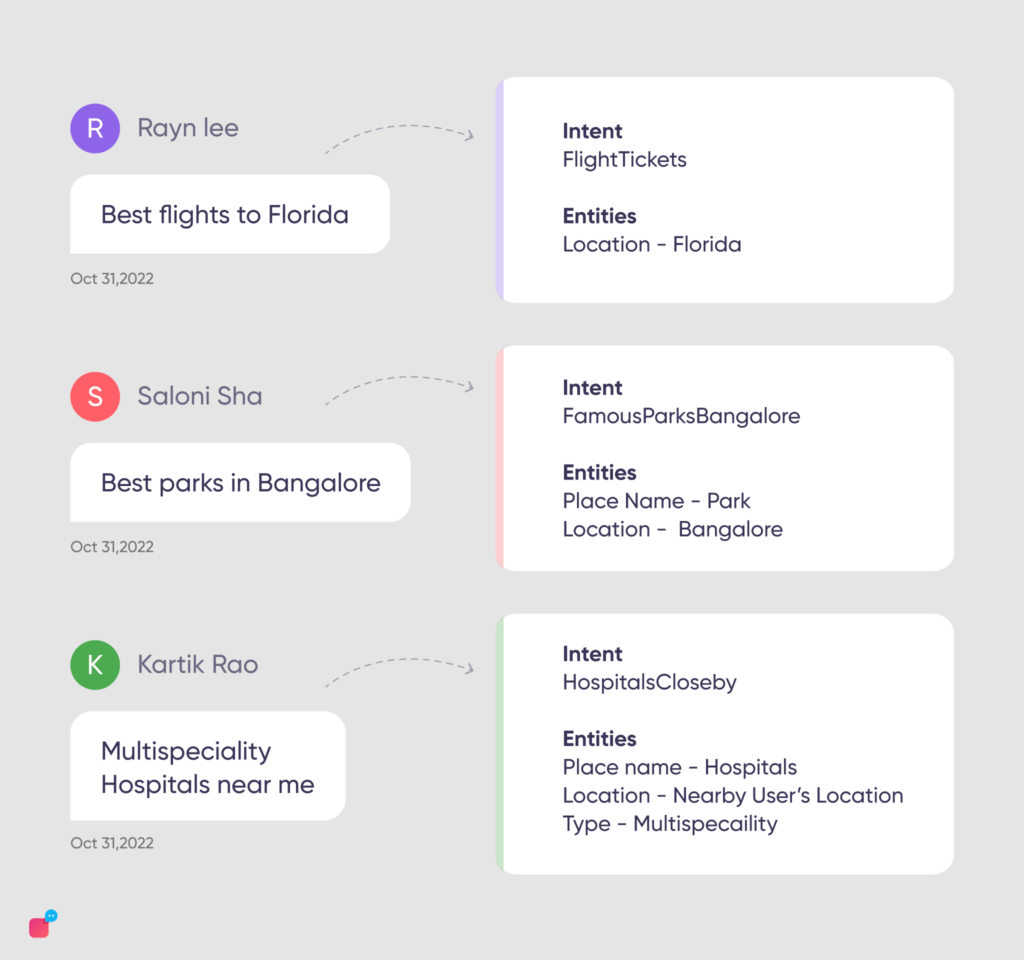
Examples of chatbot intents & entities in different industries
1. Delivery apps and services:
An average person in most urban cities uses delivery apps almost daily to meet all of their needs. Moreover, this trend is rising exponentially as these companies expand their services. Companies use chatbots for customer service and satisfaction to keep up with these rising demands. They try to collect the preliminary data and do an initial triaging of the problem using chatbots before letting human agents take over.
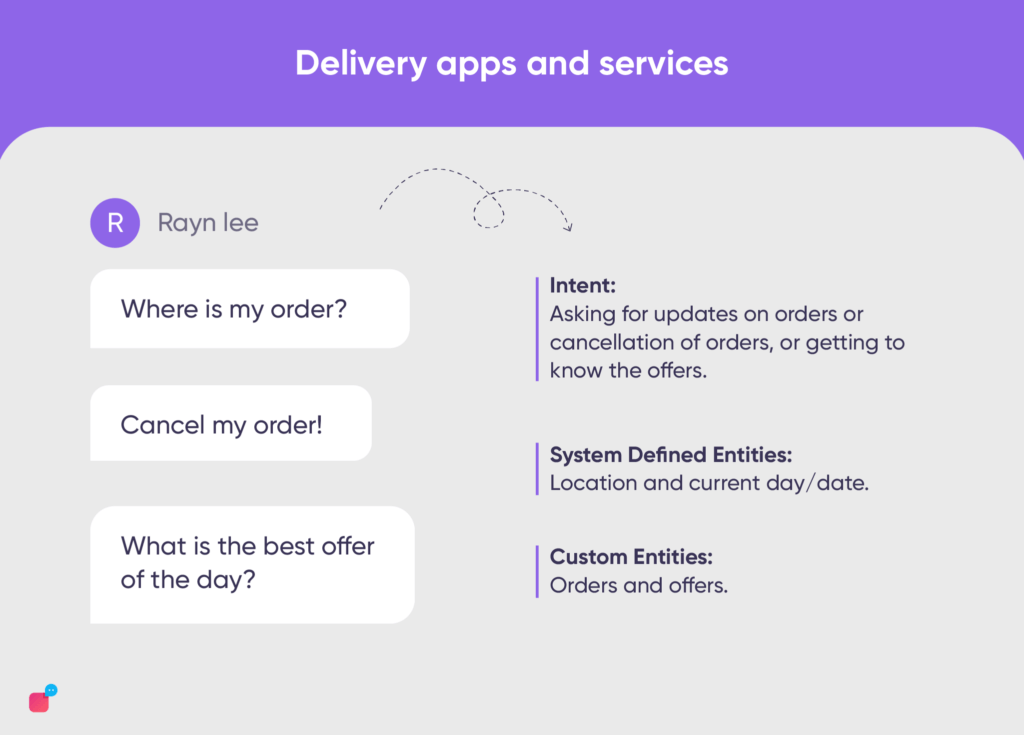
Some of the examples of queries asked by customers can be:
“Where is my order?”, “Cancel my order!”, “What is the best offer of the day?”
In the above user utterances, we can finally identify,
- Intent: Asking for updates on orders or cancellation of orders, or getting to know the offers.
- System Defined Entities: Location and current day/date.
- Custom Entities: Orders and offers.
2. E-commerce sites and platforms
Like delivery apps, E-commerce platforms certainly have evolved the concept of users interacting with a business and products. On a day-to-day basis, users reach out to specific E-commerce platforms to meet their needs at a reasonable cost! They also prioritise timely deliveries and durable products delivered to their doorsteps. In such a case, E-commerce sites utilise conversational AI and chatbots to resolve a bulk of customer service queries.
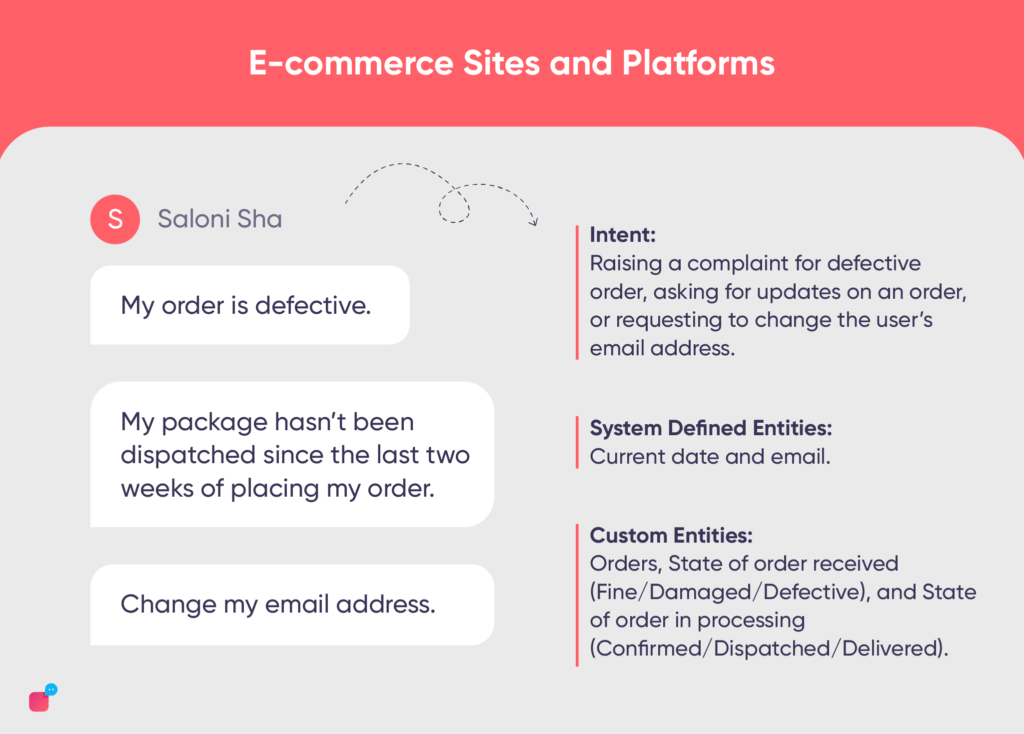
Some examples of chatbot intents and utterances initiated by customers can be:
“My order is defective.”, “My package hasn’t been dispatched since the last two weeks of placing my order.”, “Change my email address.”
In the above user utterances, we can finally identify
- Intent: Raising a complaint for defective order, asking for updates on an order, or requesting to change the user’s email address.
- System Defined Entities: Current date and email.
- Custom Entities: Orders, State of order received (Fine/Damaged/Defective), and State of order in processing (Confirmed/Dispatched/Delivered).
3. Online banking sites
Gone are the days when people stand in long queues specifically to fulfil their banking duties. Nowadays, banking transactions are incredibly safe, secure and less time-consuming, and the credit goes to banking sites that have welcomed automation to improve their processes.
They rely on Conversational AI and Chatbots to carry out numerous transactions with customers. They can be as small as paying bills, whereas checking the account balance or bank statements, resetting banking passwords, or as big as opening a new bank account and initiating fund transfers between accounts.
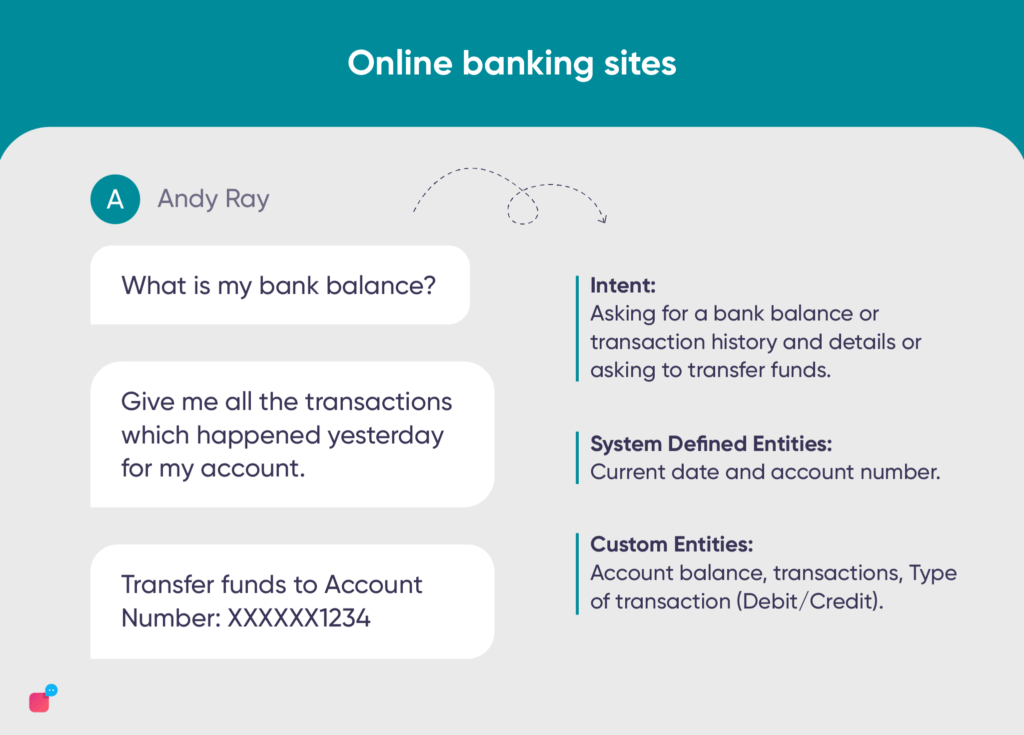
Some examples of chatbot intents and utterances initiated by customers can be:
“What is my bank balance?”, “Give me all the transactions which happened yesterday for my account.”, “Transfer funds to Account Number: XXXXXX1234”
In the above user utterances, we can finally identify
- Intent: Asking for a bank balance or transaction history and details or asking to transfer funds.
- System Defined Entities: Current date and account number.
- Custom Entities: Account balance, transactions, type of transaction (Debit/Credit).
4. Travel websites
A study by Sprinklr shows that customers prefer interacting with chatbots on a travel website because of their friendliness, reliability and responsiveness.
Some of a customer’s basic needs from a travel website are answering their queries at any given time, laying down recommendations per their preferences and budget, answering FAQs in a matter of seconds, and helping them narrow down their search as per their requirements.
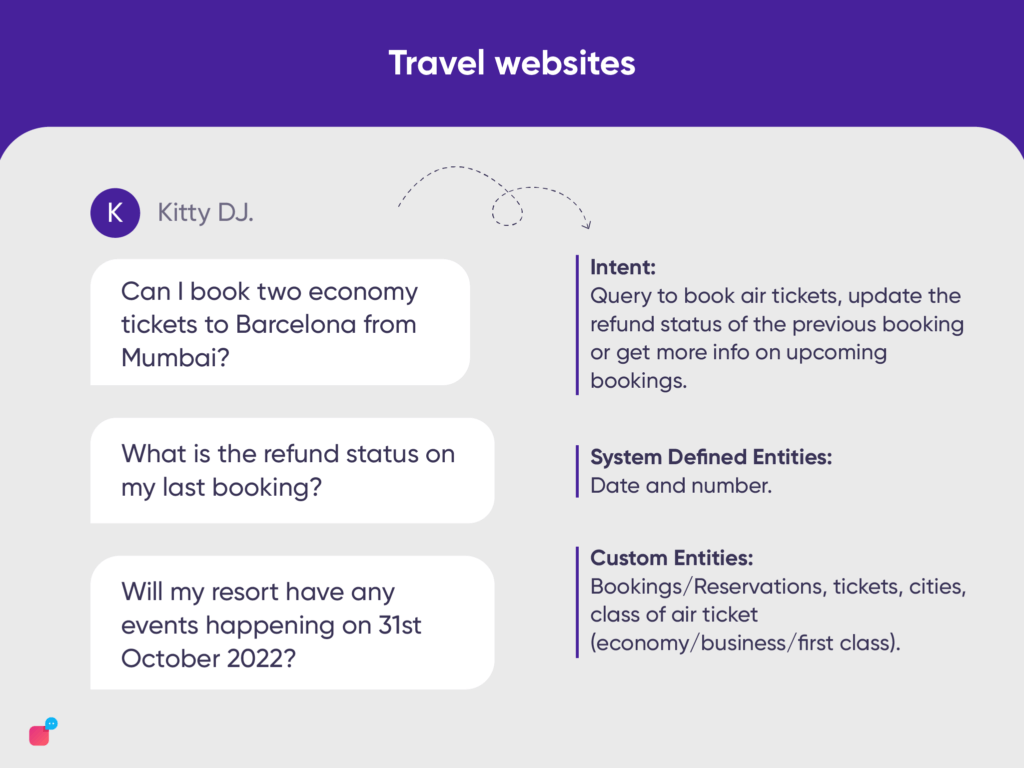
Some examples of chatbot intents and utterances initiated by customers can be:
“Can I book two economy tickets to Barcelona from Mumbai?”, “What is the refund status on my last booking?”, “Will my resort have any events happening on 31st October 2022?”
In the above user utterances, we can finally identify
- Intent: Query to book air tickets, update the refund status of the previous booking or get more info on upcoming bookings.
- System Defined Entities: Date and number.
- Custom Entities: Bookings/Reservations, tickets, cities, class of air ticket (economy/business/first class).
5. Generating marketing leads
The only way to meet customer expectations and demands is to truly understand them, break down the pain points that might be affecting them, and provide agile solutions. But how do chatbots help in this regard?
The presence of a chatbot helps by providing a smoother experience to a customer visiting a particular site for the first time. It can interact with the customer and provide swift responses, get a fair understanding of their requirements, answer FAQs and make them understand the functioning of a site. This entire transaction will ensure two things.
- The customer has received a positive experience on the site.
- A potential lead exists upon tracking down their requirements.
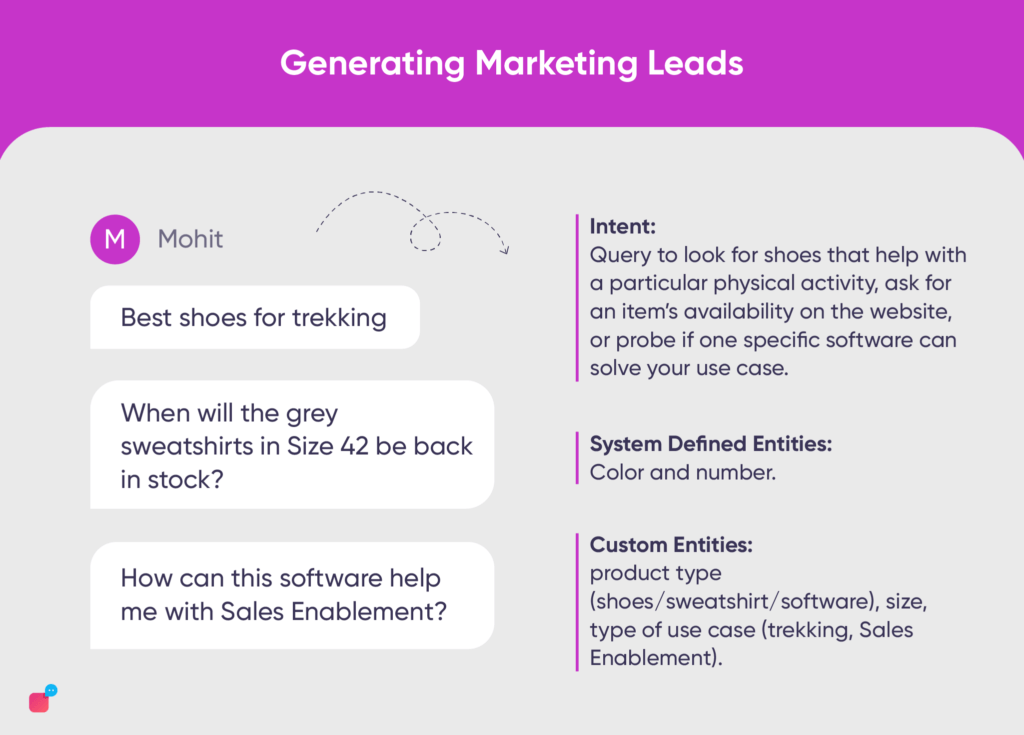
Suppose an online store installs a chatbot to understand its customer’s needs better. Some examples of chatbot intents and utterances initiated by customers can be:
“Best shoes for trekking.”, “When will the grey sweatshirts in Size 42 be back in stock?.”, “How can this software help me with Sales Enablement?”
In the above user utterances, we can finally identify
- Intent: Query to look for shoes that help with a particular physical activity, ask for an item’s availability on the website, or probe if one specific software can solve your use case.
- System Defined Entities: Color and number.
- Custom Entities: product type (shoes/sweatshirt/software), size, type of use case (trekking, Sales Enablement).
Build smarter chatbots with intents and entities
AI chatbots are taking up the world for their accuracy and natural conversations. The major NLP and Conversational AI advancements over a few years have enabled chatbots to perform significant transformations and satisfactory results in fields such as customer service and beyond.
Intents and entities are evidently a solid platform for substantial changes and improvements, right from training a chatbot to being mindful of a user’s needs and expectations or enabling a chatbot to cater to such conditions and expectations with accuracy and efficiency.
Verloop.io is the world’s leading provider of conversational AI for customer support. Our AI chatbots and voice bot solutions contain phenomenal intents and entities. Talk to our experts about what our solutions can do for your business.








